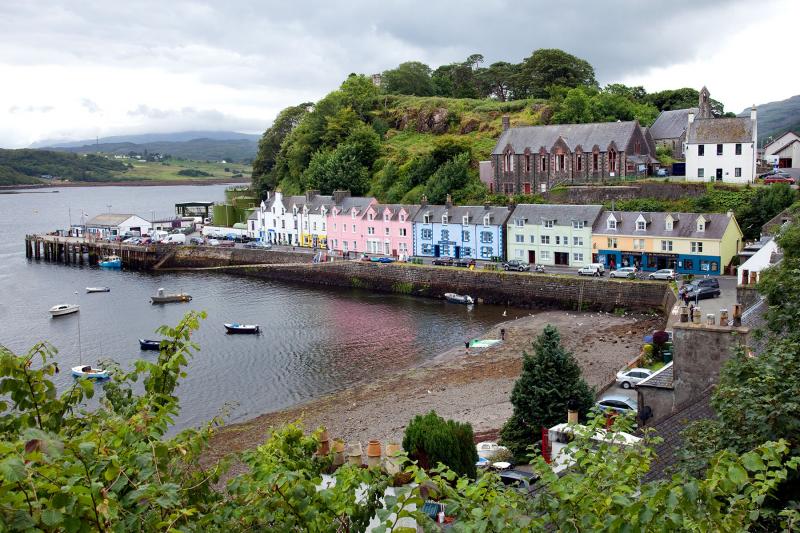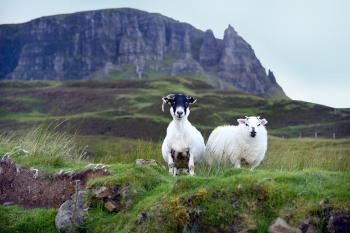Scotland's majestic Isle of Skye
Appears in the Online Edition, January 2019.
Scotland's islands may be distant fringes, but those who venture to them are richly rewarded with dramatic landscapes, a rich heritage, and a warm welcome. Among Scotland's countless islands, the favorite among travelers is the scenic Isle of Skye, with its narrow, twisty roads winding around the island in the shadows of craggy, bald mountains, and a coastline ruffled with peninsulas and sea lochs.
Just off the northwest coast, Skye is the country's second-biggest island. Though it takes two hours to drive it from south to north, it only has about 13,000 residents. The island seems to have more sheep than locals -- and it's been that way since the Highland Clearances back in the 1800s. That's when wealthy landowners decided sheep were better for their bottom line than people. Landless peasants were driven out and to this day the island's population is half what it used to be.
Connected to mainland Scotland by a bridge, Skye is a two-hour drive from Inverness, the largest Highlands city. While most travelers visit Skye as a harried day trip from Inverness, it's better to spend at least two nights here.
Skye's best home base is Portree, with a picturesque harbor area but no real sights. There are a few hotels, hostels and bed-and-breakfasts in town, while more B&Bs line the roads into and out of town. But as Skye has gotten very popular in recent years, Portree is now jammed with visitors in the summer. It's important to book accommodations as far ahead as possible.
While Portree has several good sit-down restaurants, my go-to meal is fish-and-chips at the harborside "chippy." Its outdoor picnic bench is forever empty, though, as seagulls are famously aggressive here. Hungry diners are forced to eat standing up against the wall, or else a gull will swoop down for a slab of cod.
In good weather, the island's highlight is a drive north of Portree around the Trotternish Peninsula. This drive is packed with windswept castaway views, unique geological formations, and some of Scotland's most dramatic scenery, including jaw-dropping cliffs plunging into the sea, such as the 200-foot-tall Kilt Rock, named for volcanic lava columns that look like pleats in a kilt.
It's worth getting out of the car and taking a hike. One of my favorites is the easy walk across a dramatic escarpment called the Quiraing, where landslides caused the jagged formations. Hikers are richly rewarded with a closer look at the formations and unforgettable views of the island. Even a short walk to a nearby bluff -- to get away from the cars and be alone with the wind and the island wonder -- is rewarding.
Another stop along the drive is the fine little Skye Museum of Island Life, which shows how a typical family here lived in the 1800s. Seven thatched stone huts represent a croft, or typical farming community of Scotland. In these huts, the kitchen was where all the action happened. Families would huddle around the hearth, where a peat fire would burn day and night, giving off its signature sweet, smoky smell. For social time, the community would gather for a ceilidh, where they'd gossip, drink whisky, then pick up some instruments and play music and dance.
Aside from the Trotternish Peninsula, Skye has a handful of other worthy sights. Perched on a rock overlooking a sea loch, Dunvegan Castle is the residence of the MacLeod clan, who claim that this is the oldest continuously inhabited castle in Scotland. The castle provides an interesting look at rural Scottish aristocratic lifestyles and their antiquated clan system.
For whisky lovers, a tour and tasting at the Talisker Distillery is a must. This Skye institution, which has been distilling here since 1830, is situated at the base of a hill with 14 springs. Island whisky tends to be smokier than mainland whisky due to the amount of peat smoke used during malting. It's fun to taste and compare.
If you know where to look, you'll find that the island is strewn with the scant remains of past civilizations. Just off the road between the distillery and castle hides Dun Beag, an Iron Age fort. From the parking lot, a 10-minute walk leads to a 2,000-year-old stone tower capping a hill -- a stony remnant of a long-forgotten, proto-Scottish people. It was likely built as a lookout tower and/or safe house, where families and their domesticated animals would gather in times of attack. Looking at the number of broken stones surrounding it, it's clear the tower stood much taller at one point.
Scrambling around Dun Beag is particularly evocative. Surrounded by 360 degrees of deep-green views, it feels as if you're uncovering yet another dimension of this fascinating land. And that's the appeal of this island. It's vast, beautiful, inviting and marinated in clan lore, luring the traveler ever deeper.
(Rick Steves (www.ricksteves.com) writes European travel guidebooks and hosts travel shows on public television and public radio. Email him at rick@ricksteves.com and follow his blog on Facebook.)


